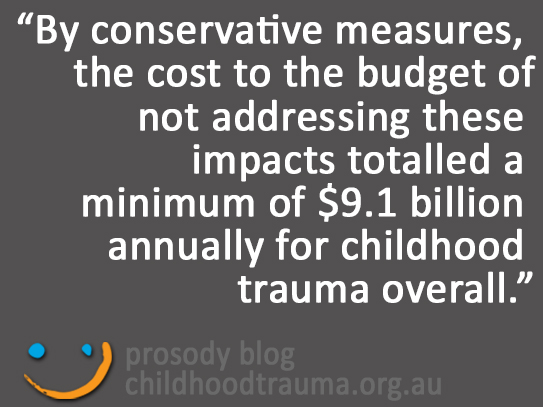
Addressing unresolved childhood trauma and abuse in adults would save Australian governments billions each year.
This article was authored by Dr. Cathy Kezelman AM is President of Adults Surviving Child Abuse,
the leading national organisation working to improve the lives of adults who have experienced
childhood trauma in all its forms. She is a survivor herself, medical practitioner by training and
a vocal advocate for systems’ change.
Adults Surviving Child Abuse (ASCA) and Pegasus Economics released a report, in February which showed that as a nation, Australia could save a minimum of $9.1 billion annually by addressing the impacts of unresolved childhood trauma in adults. Childhood trauma includes abuse in all its forms, neglect, growing up with domestic violence and the traumatic impact on children in experiencing a parental divorce or other relationship breakdown, death of a parent, an alcoholic or drug addicted parent, or a parent affected by mental illness or other significant mental health problem.
ASCA is a policy and practice leader in responding to adults traumatised as children. It has already made a significant contribution to helping to address the public health challenge childhood trauma through broad-based dissemination of its Practice Guidelines for Treatment of Complex Trauma and Trauma Informed Care and Service Delivery. Their national and international uptake has already made a significant impact on public health outcomes. This most recent report builds on prior work and that of the Royal Commission into Institutional Responses to Child Sexual Abuse, highlighting the long-term legacy of child abuse.
Given the current budget challenges this report is timely and comes in response to Prime Minister Tony Abbott’s call for alternative solutions to the Federal Government’s proposals for the Health Budget. ASCA presented these evidence-based solutions to the structural budget deficit in report – The cost of unresolved childhood trauma and abuse in adults in Australia.
 Focussing on the economic imperative for action the report highlighted the main steps to reduce these costs, including investment in specialist and trauma-informed services, training of primary care and allied health practitioners and accreditation.
Focussing on the economic imperative for action the report highlighted the main steps to reduce these costs, including investment in specialist and trauma-informed services, training of primary care and allied health practitioners and accreditation.
In its modelling the report considered the weighted costs of four of the many trauma-related issues Australian adult survivors of childhood trauma face – alcohol abuse, anxiety/depression, obesity and suicide/attempted suicide. By conservative measures, the cost to the budget of not addressing these impacts totalled a minimum of $9.1 billion annually for childhood trauma overall; or for child abuse (sexual, physical and emotional) alone, the minimum cost came to $6.8 billion annually.
The report presented the conservative estimated per affected person cost, for each of the four key areas as:
•Alcohol abuse: $4,983 per person, annually
•Mental illness: $7,686 per person, annually
•Obesity: $6,042 per person, annually
•Suicide/attempted suicide: $5,281 per person, annually
The Commonwealth Government’s latest intergenerational report (Swan 2012) showed the major future stress on government expenditures to be in health outlays, to become more marked as the population ages. ASCA wishes to work with government in response to the call for policy proposals to reduce health expenditure and improve health outcomes. Our report with Pegasus Economics identifies an area in which substantive real cost savings can be made. The long-term solutions will deliver genuine health outcomes through active, timely and comprehensive intervention.
In the report ASCA outlined the main steps to help address childhood trauma and abuse in adults, which included:
•Active investment in specialist services including professional helplines and online services, which provide support, counselling and resources to promote recovery.
•More, better trained and accredited treating practitioners who identify and address the underlying childhood trauma and abuse, rather than solely focusing on the immediate health issues, such as depression and alcoholism.
•Investing in the training of primary care practitioners. In strengthening primary health responses survivors can receive the right support, either directly or through targeted referrals, including specialist referral, ideally from an accredited practitioner. This would provide a convenient fail-safe pathway to treatment i.e. No wrong door
•System, service and institutional improvements. Financing broad-based implementation of trauma-informed practice responses (with increased awareness of trauma and its dynamics) across health and human services would help minimise the impact of trauma and the risk of re-traumatisation.
To those of us working in this field we bear witness to the devastating legacy of childhood trauma including abuse on a daily basis. For those who do not receive the right support, that legacy can be life-long but with active timely and comprehensive intervention, recovery is possible and a sense of health and wellbeing are achievable.
